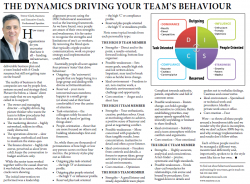Trevor Clark, Business and Executive Coach, Professional Speaker.
How many organisations do you encounter that have it all â€" funding, infrastructure, a clear, deliverable business plan and a team loaded with A-Grade resumes; but still not getting runs on the board?
The reality of business is that companies are run by people first, systems second and strategy third. Picture the below, a ‘classic’ client case study that we are regularly called in to support:
-
The owner and managing director â€" a highly driven, big picture thinker who wants the team to follow procedures but does not do so himself.
-
The marketing director â€" highly networked, seldom in office, easily distracted.
-
The operations director â€" slow to change, methodical and keen to maintain the status-quo.
-
The finance director â€" highly risk averse, perceived as aloof (even cold), keeps the conversation to budget and facts only.
While the senior team worked together well to the casual observer, it was behind the scenes, where the cracks were showing.
The initial intervention we performed was a leadership alignment process using the DISC behavioural assessment tool as the learning framework.
As we have found, once people are aware of their own strengths and weaknesses, it is far easier to recognise the strengths and limitations of one’s co-workers. By removing the blind spots that typically cripple positive communication, work on proper strategy and implementation could follow.
Essentially people all score against four primary ‘states’ that drive behaviour:
-
Outgoing â€" the ‘extroverts’; people that are happy being in a large group and dealing with diverse activities/situations.
-
Reserved â€" your more introverted team members; happier in a small group (or alone) and at their least comfortable if ever the centre of attention.
-
Task-orientation â€" the colleagues solely focused on the task at hand or ‘getting things done’.
-
People-orientation â€" those that are more focused on others and building relationships first and foremost.
So, while there are thousands of permutations of how high or low any person scores on these four metrics, the primary styles play out as follows:
-
Outgoing plus task oriented â€" the high ‘D’ or dominance profile.
-
Outgoing plus people oriented â€" the high ‘I’ or influencer profile.
-
Reserved plus task oriented â€" the high ‘C’ or compliance profile.
-
Reserved plus people oriented â€" the high ‘S’ or steadiness profile.
Note some typical trends from each personality type:
THE HIGH D TEAM MEMBER
-
Strengths â€" Direct and to the point, a results-oriented, forward looking, bottom-line organiser.
-
Possible weaknesses â€" Sets many goals, usually high risk and not written down. Impatient, may tend to break rules as he/she loves change.
-
Ideal environment â€" Freedom to act, non-routine work, a futuristic environment with challenge and opportunity.
-
Core emotion â€" Anger and a short fuse
THE HIGH I TEAM MEMBER
-
Strengths â€" Your enthusiastic, creative, problem solver. Great at motivating others to achieve, a positive sense of humour and good at negotiating conflict.
-
Possible weaknesses â€" More concerned with popularity than tangible results, loses concentration, inattentive to detail and often a poor listener.
-
Ideal environment â€" Freedom from controls and details, a forum to express ideas, group activities in professional and social environments.
-
Core emotion â€" Optimism
THE HIGH S TEAM MEMBER
-
Strengths â€" A good listener and steady, dependable team player. Compliant towards authority, patient, empathetic and full of common sense.
-
Possible weaknesses â€" Resists change, can hold a grudge and sensitive to criticism. Battle establishing priorities, may appear openly agreeable but inwardly unyielding or hesitant to share feedback.
-
Ideal environment â€" Stability and a team atmosphere with few conflicts and arguments.
-
Core emotion â€" Non-emotional
THE HIGH C TEAM MEMBER
-
Strengths â€" Highly accurate, analytical and conscientious. A fact-finder â€" precise, systematic and high standards.
-
Possible weaknesses â€" Needs clear-cut boundaries for relationships, risk averse and bound by procedures. Gets bogged down in details and prefers not to verbalize feelings. Cautious and conservative.
-
Ideal environment â€" Specialised or technical work and procedures. Ideally a private work area or office.
-
Core emotion â€" Fear
Wow â€" so throw all these people around a boardroom table and we wonder why the plan is incomplete, why we don’t achieve 100% buy-in, and why strategy implementation and results don’t follow either.
Each of these people need to be managed a different way, incentivised differently and, importantly, spoken to in the style most like his or her own.
To find out about behavioural assessments and training for your team, get in touch on:
Tel: 031 266 2258
durban@actioncoach.com
www.mastery.co.za
